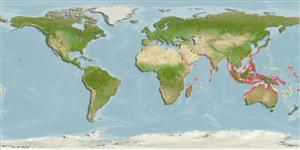Common names from other countries
>
Gobiiformes (Gobies) >
Gobiidae (Gobies) > Gobiinae
Etymology: Glossogobius: Greek, glossa = tongue + Latin, gobius = gudgeon (Ref. 45335).
More on author: Hamilton.
Environment: milieu / climate zone / depth range / distribution range
ນິເວດວິທະຍາ
ສັດທະເລ; ນ້ຳຈືດ; ນ້ຳກ່ອຍ ກ່ຽວກັບ (ຢູ່)ເທິງຊັ້ນພື້ນດິນໃນທະເລເປີດ; ປາທີ່ມີການເຄື່ອນຍ້າຍຈາກທະເລໄປຫານ້ຳຈືດ ແລະນ້ຳຈືດຫາທະເລ (Ref. 51243); ລະດັບຄວາມເລິກ 0 - 5 m (Ref. 86942). Tropical; 25°C - ? (Ref. 2059); 30°N - 32°S, 25°E - 176°E
Africa to Oceania: Red Sea and East Africa, south to Transkei in South Africa, and most inland freshwater bodies over the Indian Ocean and western Pacific (Ref. 4343, 52193). Common in coastal and estuarine waters from austral Africa and Madagascar to India and south of China.
Length at first maturity / ຂະໜາດ / ນ້ຳໜັກ / Age
Maturity: Lm ?, range 9 - ? cm
Max length : 50.0 cm SL ຕົວຜູ້/ບໍ່ມີເພດ; (Ref. 4967); common length : 11.3 cm SL ຕົວຜູ້/ບໍ່ມີເພດ; (Ref. 35840)
ຄີ (ໜາມ)ແຂງຢູ່ຫຼັງປາ (ທັງໝົດ) : 7; ຄີຫຼັງຂອງປາ (ຄີອ່ອນ) (ທັງໝົດ) : 8 - 9; ຄີ(ໜາມ) ແຂງຢູ່ຄີກົ້ນປາ
ກຸ່ມປາກະດູກແຂງ
ຄວາມຖີ່ຂອງກຸ່ມຖ່າຍທອດພັນ
ປາທີ່ມີການເຄື່ອນຍ້າຍຈາກທະເລໄປຫານ້ຳຈືດ ແລະນ້ຳຈືດຫາທະເລ
ປາທີ່ມີການເຄື່ອນຍ້າຍຈາກທະເລແລະໄປໄຂ່ຢູ່ນ້ຳຈືດ
ຄີກົ້ນຂອງປາ
ສັດທີ່ມີກະດູກສັນຫັຼງ
ການຖ່າຍທອດທາງກຳມະພັນຈາກພໍ່ແມ່ຫາລູກ: 1; ຄີກົ້ນຂອງປາ: 8 - 9.
Found mainly in freshwater and estuaries, but also enter the sea (Ref. 4833). Also occur in canals, ditches and ponds (Ref. 12693). Found in clear to turbid streams with rock, gravel or sand bottoms (Ref. 2847). Encountered in medium to large-sized rivers of the lower Mekong (Ref. 12975). Feed on small insects, crustaceans and small fish. Grow to a much larger size in brackish water than in fresh water. Marketed fresh (Ref. 12693). Cannibalism is relatively common for this species (Ref. 48660).
Life cycle and mating behavior
Maturities | ການສືບພັນ | Spawnings | Egg(s) | Fecundities | ຕົວອ່ອນ
Spawning occurs in freshwater afterwhich eggs and larvae are washed down by the river current into the sea (Ref. 110258).
Maugé, L.A., 1986. Gobiidae. p. 358-388. In J. Daget, J.-P. Gosse and D.F.E. Thys van den Audenaerde (eds.) Check-list of the freshwater fishes of Africa (CLOFFA). ISNB, Brussels; MRAC, Tervuren; and ORSTOM, Paris. Vol. 2. (Ref. 4343)
IUCN Red List Status (Ref. 130435)
CITES (Ref. 128078)
Not Evaluated
Threat to humans
Harmless
Human uses
ການປະມົງ: ທີ່ເປັນການຄ້າໜ້ອຍ; ການລ້ຽງສັດນ້ຳ: ເປັນສີນຄ້າ; ຕູ້ປາ: ເປັນສີນຄ້າ
ເຄື່ອງມື
Special reports
Download XML
ແຫຼ່ງອີນເຕີເນັດ
Estimates based on models
Preferred temperature (Ref.
115969): 25 - 29.3, mean 28.5 (based on 2836 cells).
Phylogenetic diversity index (Ref.
82804): PD
50 = 0.5000 [Uniqueness, from 0.5 = low to 2.0 = high].
Bayesian length-weight: a=0.00724 (0.00642 - 0.00818), b=3.07 (3.04 - 3.10), in cm Total Length, based on LWR estimates for this species (Ref.
93245).
ຊັ້ນເຂດຮ້ອນ (Ref.
69278): 3.7 ±0.2 se; based on diet studies.
ຄວາມຢືດຢຸ່ນ (Ref.
120179): ສູງ, ປະຊາກອນຕຳ່ສຸດທີ່ໃຊ້ເວລາສອງໜ້ອຍກວ່າ 15 ເດືອນ (K=0.8; Fec=18,578;).
Fishing Vulnerability (Ref.
59153): Low to moderate vulnerability (26 of 100).
